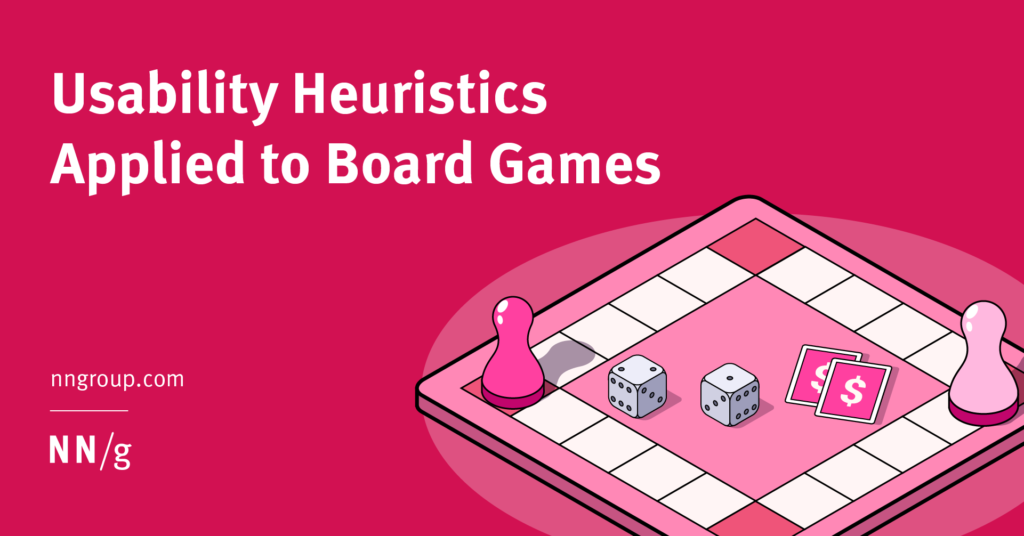Summary:
Usability heuristics suggest what influences the design of successful board games.
Despite the proliferation of digital entertainment, board games have never been more popular. Worldwide, board games are a 13-billion-dollar industry.
But what makes a board game successful? While there are many theories, we surmise that two crucial attributes are fun and usability. Sometimes these go hand in hand; sometimes they are in conflict. This article discusses fun and usability in board-game design through the lens of the 10 usability heuristics.
Visibility of Status
Board games should always keep players informed of their status in the game. (Read the full article on the visibility of system status heuristic.)
“How am I doing?” and “What can I do?” are frequent questions for players. Board games use various techniques to convey this information and reduce cognitive load. These techniques include scoring tracks to communicate player progress towards victory or pawns to mark positioning on a game board.
In the classic word game Scrabble, players write down their scores on a scoring sheet after each turn. The scores are known to everyone during the game, and the players use slanted trays to arrange their letter tiles so they can see them better. (It would be hard to play Scrabble with your letters hidden!) Some game versions also have an hourglass timer to show how much time the player has left to make a word and keep the game moving.
Why Break This Heuristic in Board Games?
Concealing some types of information can increase fun in several ways. Hiding the point totals of other players can reduce players’ tendency to tear down the leader. Some games have adversarial player roles. For example, in the game Fury of Dracula, Dracula’s movement is hidden from the vampire hunters.
Breaking this heuristic is best applied to other players’ information to create fairness or tension; the players’ own information should be easily accessible.

Match Between Game and the Real World
Board games should speak the players’ language. Use words, phrases, and concepts familiar to people rather than jargon or highly abstract ideas. Follow real-world conventions and convey information in a natural and logical order. (Read the full article on matching the system and the real world.)
Aligning a game to the workings of the real world can be a boon for a game’s learnability. This approach taps our existing knowledge and intuition to reduce mistakes and quickly learn game rules.
Abstract games can struggle with this heuristic since their themes are reduced or absent. For example, in chess, the horse-shaped knight piece moves in an L-shaped pattern on the chessboard, but no real-world parallel explains why that’s the case. The only thing restricting the knight’s movement on the chessboard’s square grid are the rules the chess player learned and committed to memory.
Santorini is also an abstract game, but it has a well-integrated theme that enhances its usability. In Santorini, players build towers from the scenic Greek island of the same name. Players use their figures to construct these towers piece by piece; the first player to have one of their figures standing on a 3-level tower wins.
If your rival suspects you will move to the top of a nearly finished tower, they can build one of the striking blue domes to complete it. This rounded dome physically obstructs players from placing their figures on the completed tower. The movement rules are also clever—a player can move up 1 level on an incomplete tower (like the effort of climbing up something) but can move down any number of levels (like the ease of jumping down due to gravity). These small touches combine to create a game that’s easier for a novice to play intuitively.

Why Break This Heuristic in Board Games?
Plenty of games do not have strong real-world connections and remain fun; go, chess, and checkers are among the most popular board games in the world and are mostly comprised of contrasting pieces placed on a grid. Letting go of real-world conventions can empower designers to design games with engaging decisions or competition, so long as they keep the rules well-documented and simple enough to balance the impact on usability.
Player Control and Freedom
Allow players to exercise their autonomy and decision making within the board game’s rules. (Read the full article on user control and freedom).
Classic board games like Checkers or Battleship give all players the same starting pieces. Limiting and standardizing the potential decisions that a player can make has advantages — it reduces the cognitive load on players and simplifies the game’s rules — but each play of the game will be similar as a result. Offering players more decision-making agency can significantly enhance the game’s longevity.
The enduringly popular Dungeons and Dragons is a famous example that adheres to this heuristic. Players roleplay as adventuring fantasy heroes and are encouraged to use their imagination and creativity to overcome challenges. While the game’s expansive rules can be a barrier, those players can use simplified rules to focus on story-telling and problem-solving through weapons, wizardry, or words. A game of Dungeons and Dragons can provide years of enjoyment.
Why Break This Heuristic in Board Games?
Sometimes games break this heuristic for reasons outside the game itself. In Candyland, players move their gingerbread character pawns along a colorful, candy-themed trail by drawing a movement card. Shuffling these cards determines the game’s winner. Players have no decisions to make and no control over the outcome.
That said, Candyland targets young children who are unfamiliar with the act of playing any formalized game at all. Breaking this heuristic allows older players to role model how to follow rules, cope with setbacks, and demonstrate healthy gaming etiquette with an easy-to-follow ruleset. But this gives Candyland a short shelf life: players will quickly move on to other games offering more control.

Error Prevention
Prevent problems from occurring in the first place. Eliminate failure-prone situations early in the board game. (Read the full article on preventing user errors).
Users are often working to accomplish a goal when using apps and websites. Preventing errors in this context clearly reduces frustration. However, heavily error-proofing a game would reduce player autonomy and sap the fun of playing. It’s okay for players to make mistakes through their inexperienced judgment; challenge is necessary for fun. But what is the feedback for these mistakes, and when does it occur?
Older board games such as Risk or Sorry! feature the ability to eliminate another player’s progress or even the player! These feedback mechanisms have rightfully fallen into disuse in modern board games for their effect on players. Instead, usable board games keep players playing and reduce the potential for game-ending errors in the opening moments. Playtesting is vitally important here; it helps identify error-prone game rules, poor component design, or significantly imbalanced strategies harming the game’s perceived fun and fairness.
For example, in the social deduction game Bang!, players assume roles of sheriffs or outlaws attempting to be the last one standing in a Wild West shootout. Although unlikely, a player can have the right combination of cards to eliminate another player in the first round of the game — before their victim has even taken their first turn! Losing this way and being excluded from the rest of the game can feel unfair and lead players to avoid the game in the future.

In other cases, the board game’s design contributes to errors by violating classic accessibility rules. The game Trouble has uniform game pieces that are distinguishable only by their color. Encoding this information exclusively through color makes it challenging for players with color-vision deficiency to identify their pieces correctly.
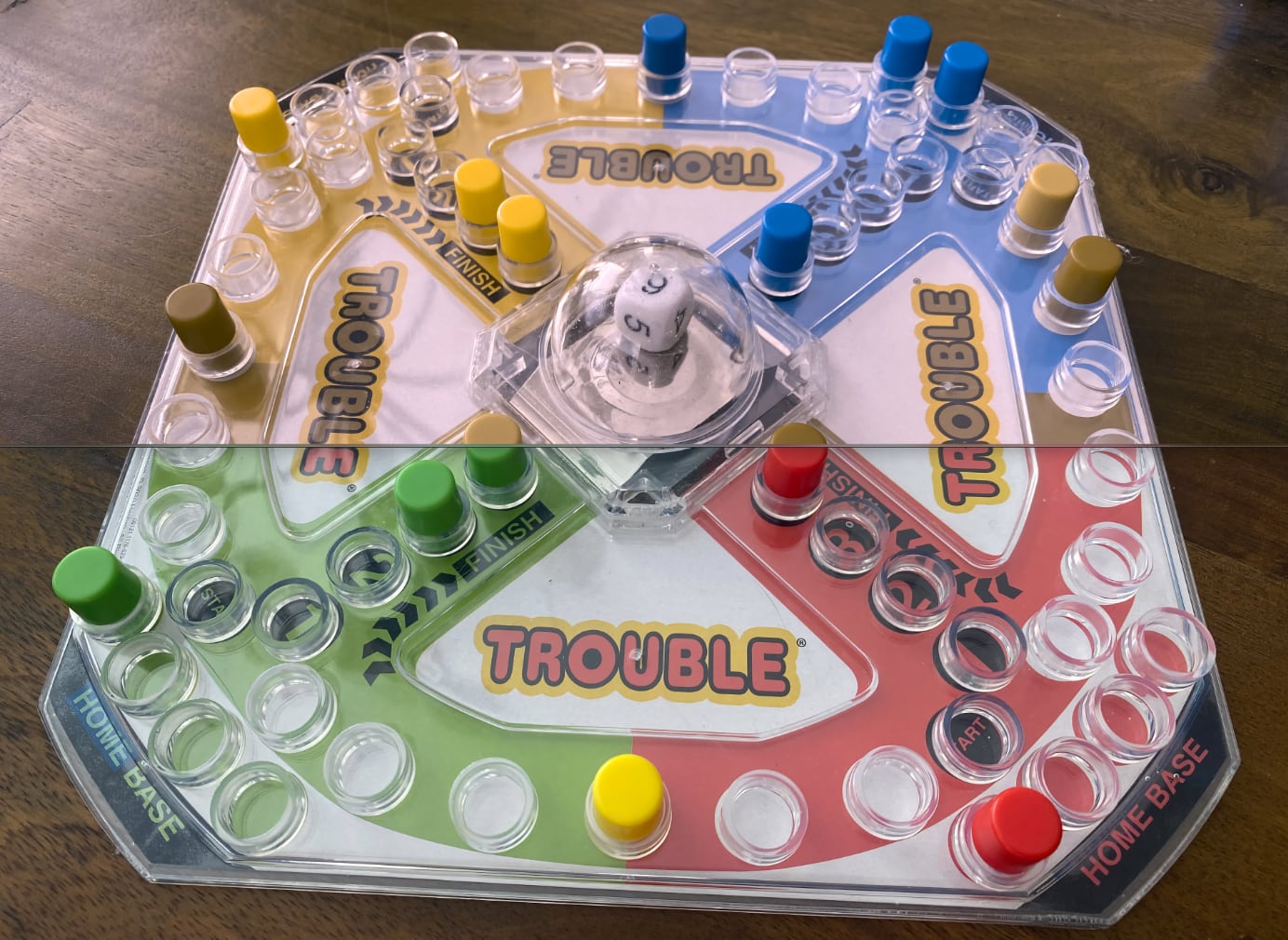
Why Break This Heuristic in Board Games?
Intentionally including errors related to component design or overpowered strategies has little fun value. But risky errors in player strategy? That can be a source of excitement. For instance, should a player be disallowed from making a massive bet in a hand of poker? Should Risk only allow attacks where both armies have equal strength? Casino gambling excluded, board games generally involve imaginary resources that players can safely wager. Improbable triumph or disastrous loss resulting from a foolhardy play can be a memorable experience that passes into legend for those players.
Recognition Rather than Recall
Minimize the player’s memory load by making elements, actions, and options visible. Information required for gameplay should be visible or easily referenced when needed. (Read the full article on memory recognition and recall).
As board-game design has grown more complex, players’ working memory has become a crucial resource to manage. Therefore, game designers often create rule-reference components or other cues to aid in remembering rules. Sometimes these cues are icons, which can easily fit on small game components and make the game language-independent and easy to internationalize. But these icons (which can be tricky to understand) may only increase the cognitive load on players.
In Minecraft: Builders and Biomes, players simulate building a town from the digital version of the game. Many game pieces use a variety of icons to communicate how to play. Minecraft enthusiasts might recognize some icons based on their game knowledge (like the green dot for gaining experience). Still, for everyone else, it means pausing the game and referencing the rulebook until these rules and icon associations are formed.

In Twilight Imperium, players play as science-fiction empires attempting to rule the galaxy through politics, trade, or warfare. This game is quite complex and contains many rules, but it uses well-designed player mats with textual rule references that can be quickly checked without resorting to the rulebook.
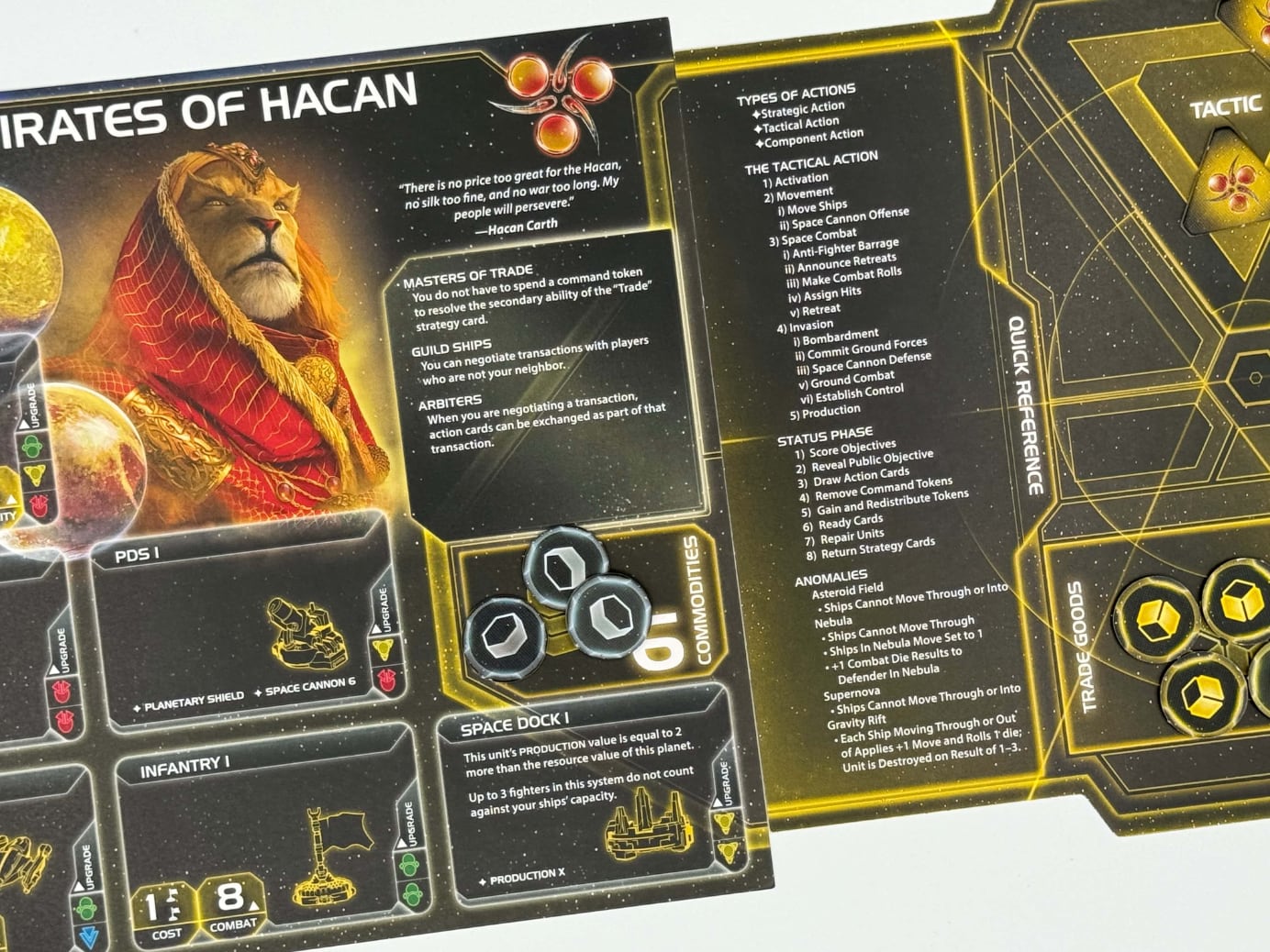
Why Break This Heuristic in Board Games?
Economics often comes into play when breaking this heuristic. Printing rules reminders and increasing game-component size also increase manufacturing costs and the board game’s resulting price, which can reduce market size.
Some games heavily tax the player’s working memory, like remembering the identity and position of game pieces in Stratego or Guess Who. These games can be fun — bridge is a popular card game where tracking played cards is a substantial advantage — but they obligate the player to commit a high-degree cognitive resources to play effectively. This approach reduces the inclusiveness of the game and excludes segments of the player community willing or able to play it.
Aesthetic and Minimalist Design
The board game’s visual design should not contain irrelevant or rarely needed information. Every extra unit of information in the board game competes with the relevant units of information and diminishes their relative visibility. (Read the full article on aesthetic and minimalist design).
Careful art direction that guides the player’s attention to essential game pieces or rules can enhance a board game’s usability. Board-game creators have come to appreciate the aesthetic-usability effect — a new board game with a novel theme and beautiful pieces can attract attention while masking the game’s flaws (in the short term, at least). Recently, board-game creators have exploited this heuristic to create new forms of gameplay (legacy games) where the game slowly reveals its full potential as players play it.
In Zombie Kidz Evolution, players work together to defeat zombies invading their school. As players win games, they earn achievements that unlock new abilities and opponents. These new pieces are packaged in sealed envelopes to remove distractions and focus younger players (the game’s target audience) on the basics. New rules are printed on stickers that are placed on empty spots in the rulebook. By progressively revealing these components, the game guides players to master the fundamentals, while preserving mystery and excitement for what will unlock next.
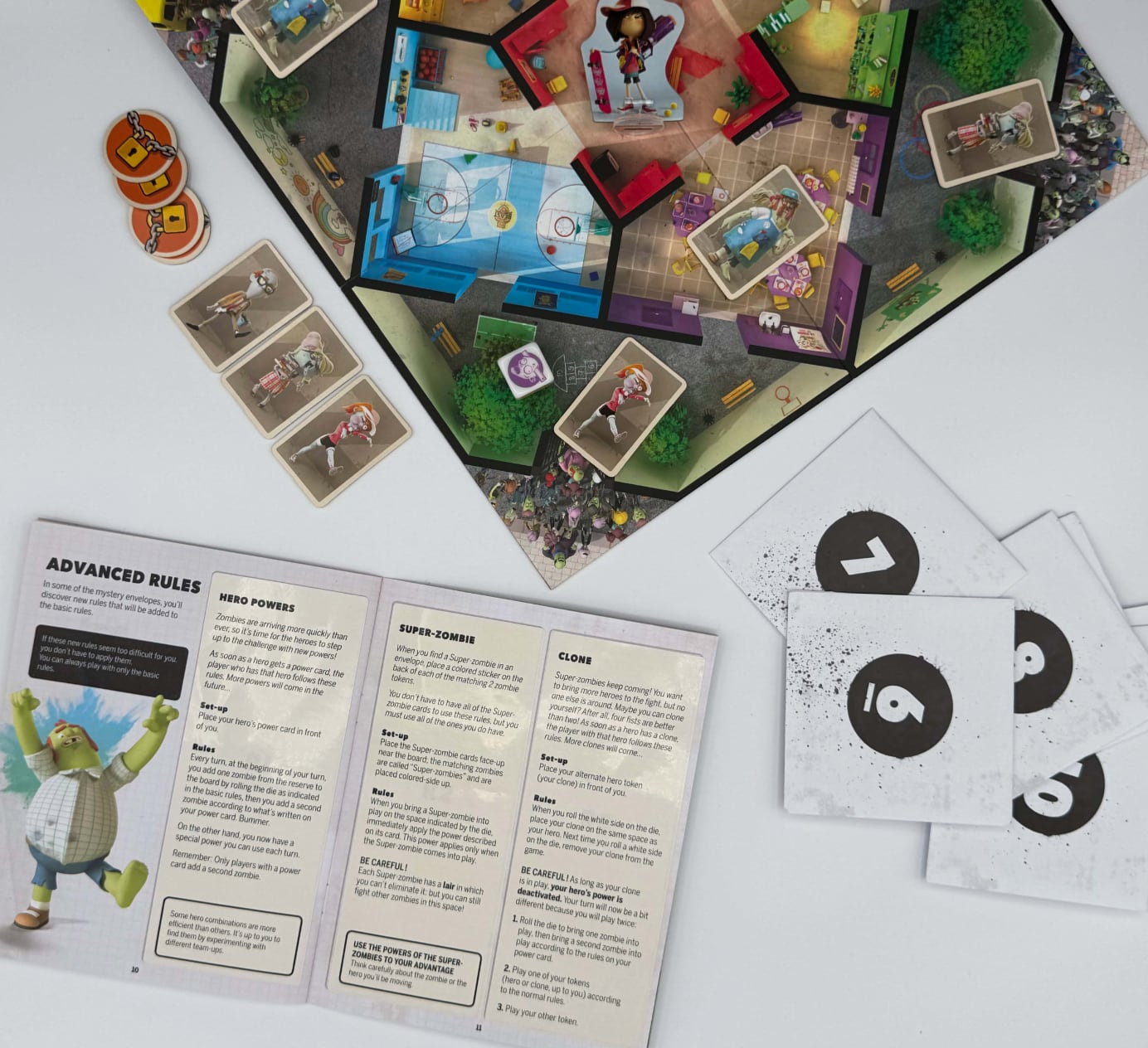
Why Break This Heuristic in Board Games?
Again, there are more economic incentives to follow this heuristic than to violate it. A board game’s visual design needs a surface, and that surface is expensive to manufacture. Ugly games may initially save a few pennies in production costs but will have difficulty competing in today’s competitive board-game marketplace. Older games that may have broken this heuristic with drab, uninspired art of medieval kings or farmers have found new audiences in the form of revised editions with art direction from skilled visual designers.
Help Players Recognize, Diagnose, and Recover from Mistakes
Players, especially new ones, will make mistakes. Provide players with resources or guidance to undo their mistakes without added effort. (Read the full article on helping users with errors).
Accommodating players of different skill levels can broaden a board game’s appeal. Experienced players will make fewer mistakes and likely outperform newer players, which can harm the fun in competitive games and sour a new player’s experience. Since designers want all players to remain engaged, reducing the impact of a “runaway leader” becomes essential for the game’s replayability.
In The Quacks of Quedlinburg, players act as unscrupulous potion makers trying to score points by adding the right combination of ingredients to their mixing pot. During their turn, players draw ingredients from their ingredient bag, but some ingredients will cause their potion to explode and slow their progress. If a player (though skill, luck, or both) pulls far ahead in scoring, the game awards “rat tail” ingredients to the lowest-scoring players, temporarily boosting their scoring potential in the next round.
This mechanic is a good design tactic; remember that people have a strong negativity bias and hate having things taken away from them. It’s far better to give a scoring boost to lagging players than take away earned points from the leader.

Why Break This Heuristic in Board Games?
Like with the error-prevention heuristic, this heuristic may be broken so that each game decision is impactful and consequential. This works best for short games, so the player’s time investment is small and the lasting impact of their errors reduced.
Help and Documentation
It’s best if the board game doesn’t need any additional explanation; however, it may be necessary to provide documentation to help players play the game. (Read the full article on help and documentation).
Playing a board game is fun! Reading a dense rulebook? Not so much. Although rulebooks are necessary to convey a game’s rules, they’re neither a joy to read nor very helpful when teaching a group of inattentive friends.
Some board-game companies recognize that the helpfulness of their documentation improves usability and influences player adoption. For example, the publisher of SkyTeam (a cooperative game of pilots flying an airplane) provides a link to an official how-to-play YouTube video to cater to players who prefer to learn visually or want to quickly teach their partner.

The rulebook’s design can also interfere with its helpfulness. In the game First Martians (about astronaut explorers settling on Mars), many rulebook rules have a convoluted layout that uses multiple crossreferences, callouts, and sidebars. The result is a slog to read and efficiently reference when questions arise.
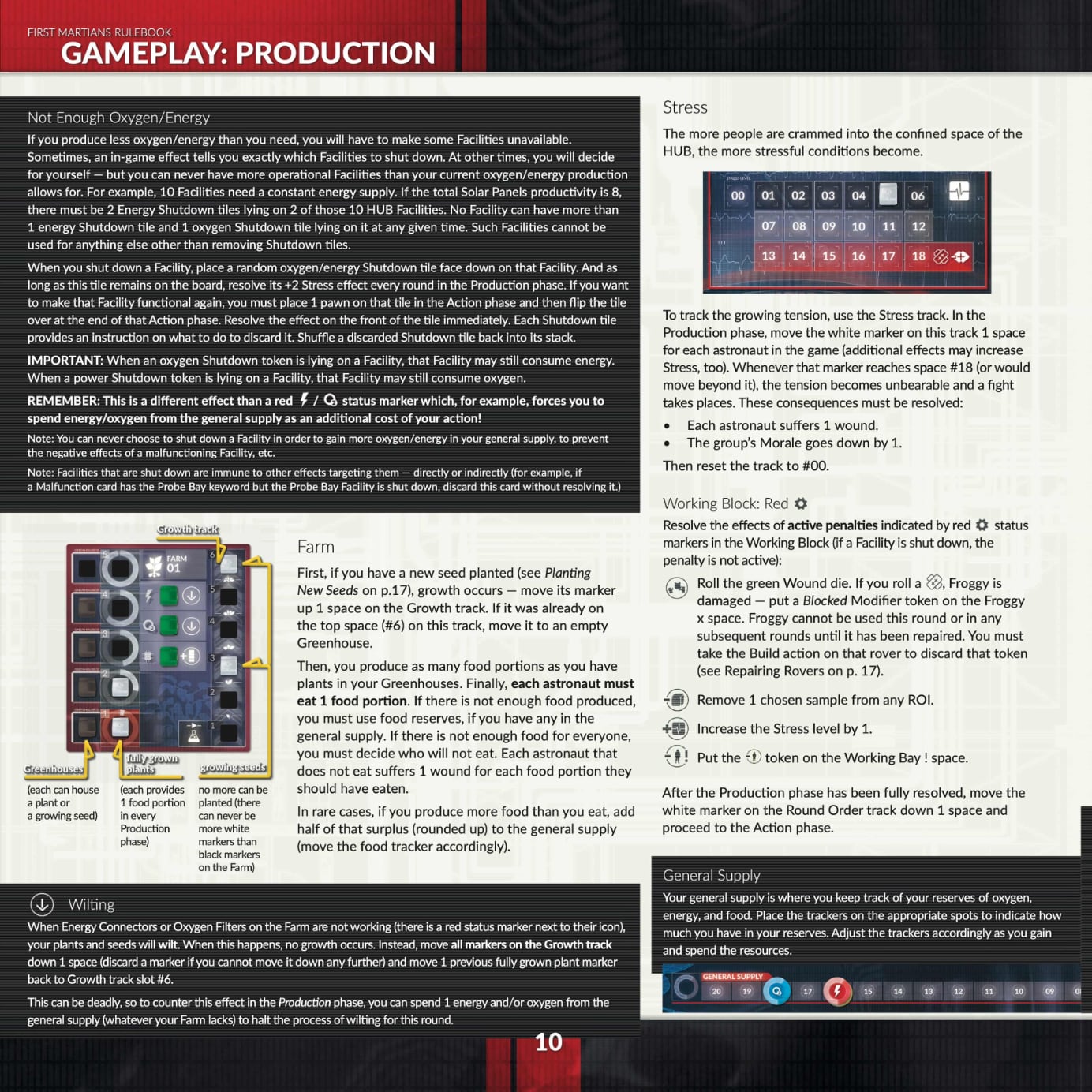
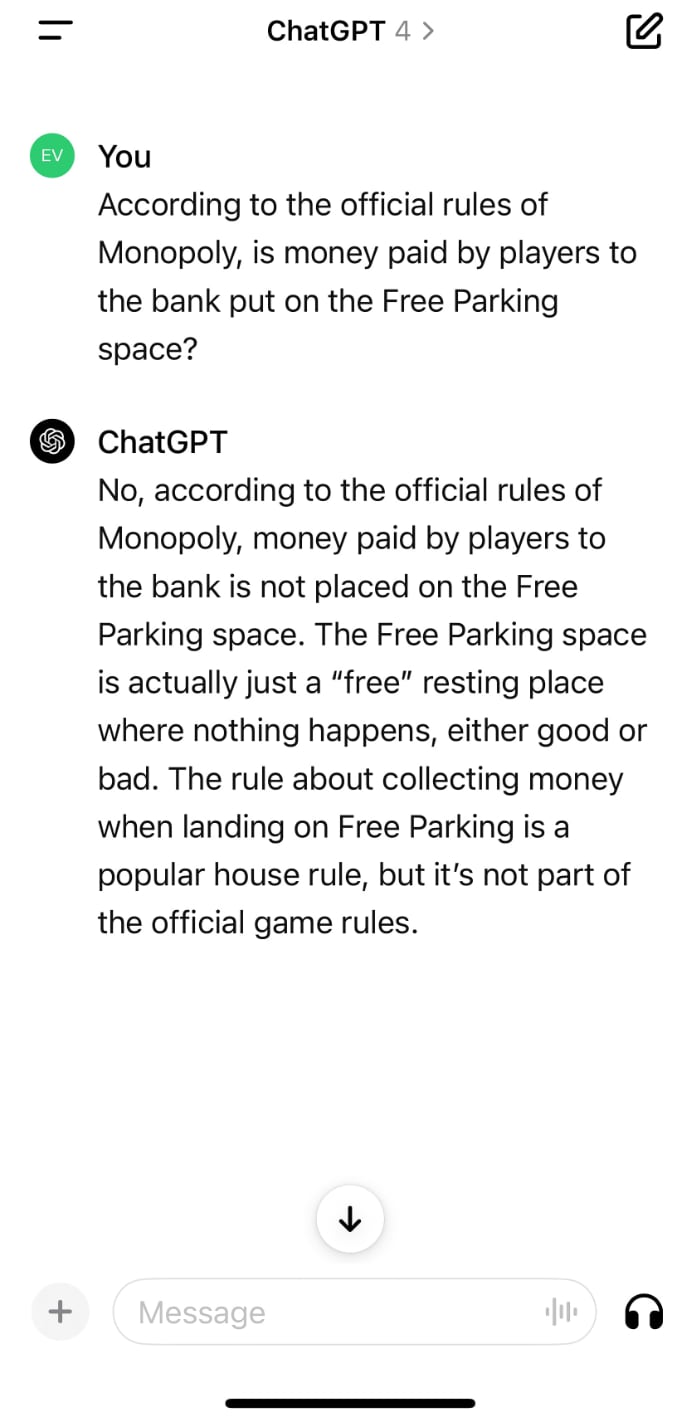
Why Break This Heuristic in Board Games?
There’s minimal upside to breaking this heuristic. Games are not inherently intuitive; they must be taught to be played. Unusable rule documentation just makes an unfun activity even more discouraging.
Differentiating Between Fun and Work
Although we’ve discussed why breaking some of these heuristics and reducing usability can increase fun in certain board games, it doesn’t mean that you should do the same on your website or in your app. When users are task-oriented, they won’t appreciate hidden information, figuring out puzzles, or being subjected to randomness. In contrast, in board games, people are seeking to be entertained and willingly consent to some level of learning, challenge, luck, and the potential of winning or losing. But losing a game is mostly harmless (so long as you’re not betting real money). “Losing” at work-related tasks can have real consequences such as abandonment, dissatisfaction, or lost productivity.
Balancing Physical Constraints and Economic Tradeoffs
Board-game designers cannot escape viability and feasibility considerations when balancing these usability heuristics. Board games must be profitable for the business and economically manufactured from physical materials.
For example, assume a game where players frequently forget how many actions they’ve taken on their turn. The board game’s designer considers including additional tokens for players to track this information. How costly are those extra pieces to produce and how will this impact the packaged game? How serious are the consequences of leaving this issue unaddressed compared to other decisions requiring budget? Do players even use these pieces while playing the game?
Navigating constraints and difficult tradeoffs comes with any design job. (And board-game designers have it worse than digital UX professionals — they can’t quickly patch the board game to fix usability issues once it’s shipped to the marketplace.) These are all good reminders of the benefits of prototyping a new game with cheap materials and usability testing with players to iterate and improve it. Such timeless techniques enhance usability regardless of what is being designed.
Conclusion
The next time you gather around the family dinner table for a board-game night, notice those moments when a player struggles to interpret an icon on a card or accidentally forgets a game rule. How did it impact the game’s usability — and, ultimately, the fun? Honing your perceptiveness at work and play will help you be a more deliberate and effective designer.

